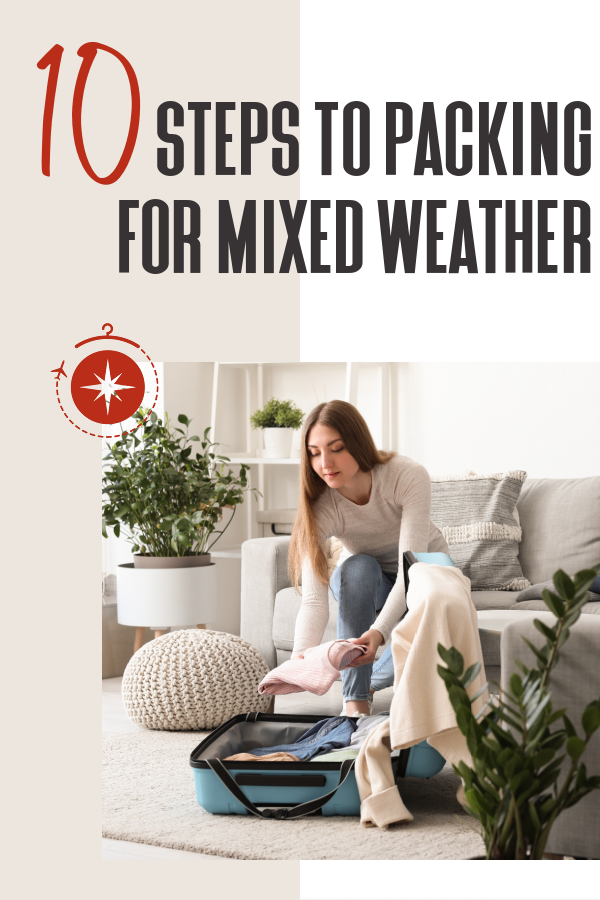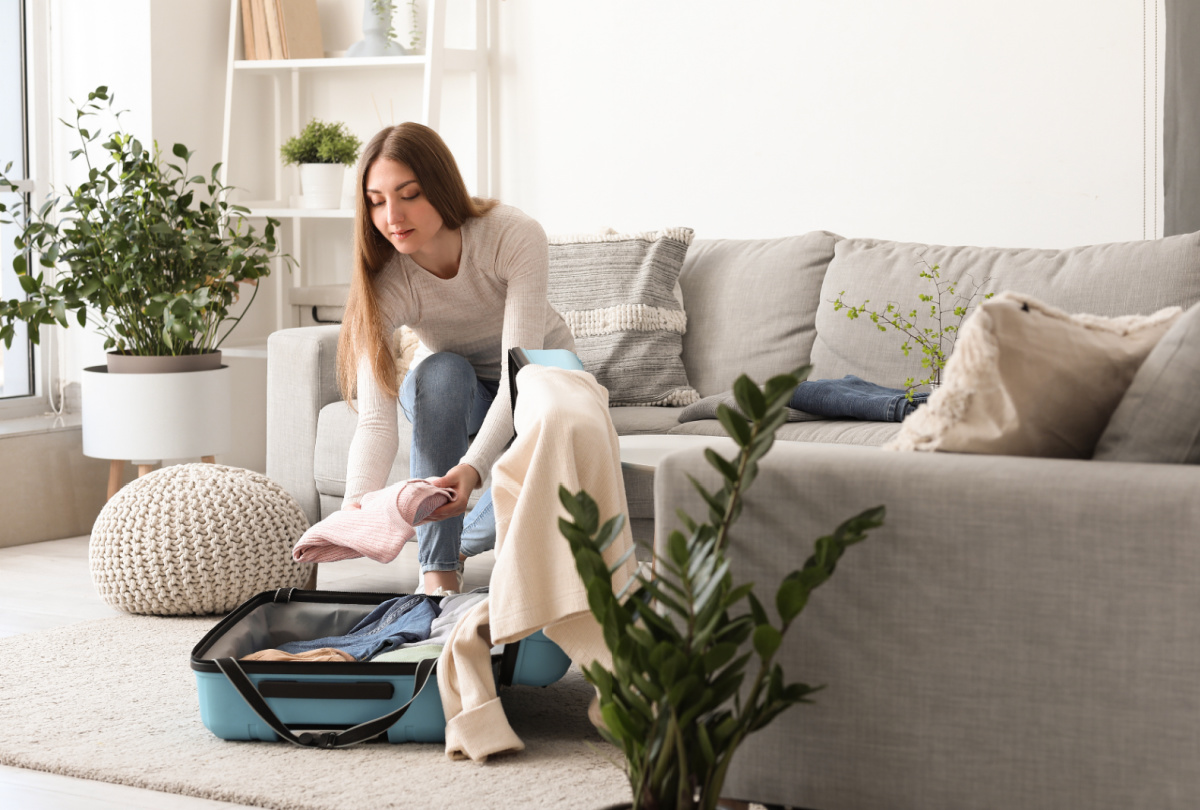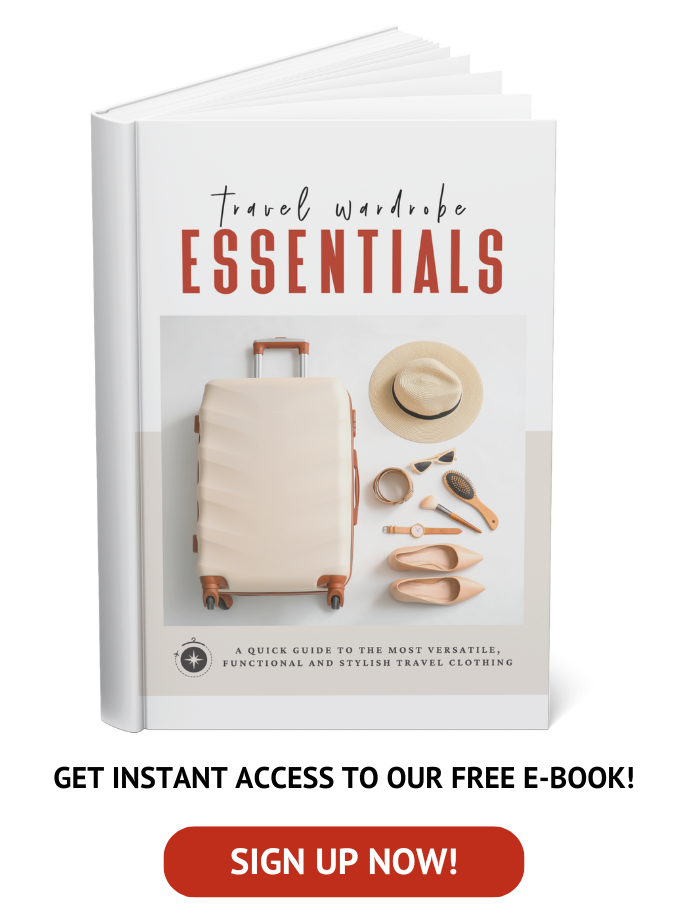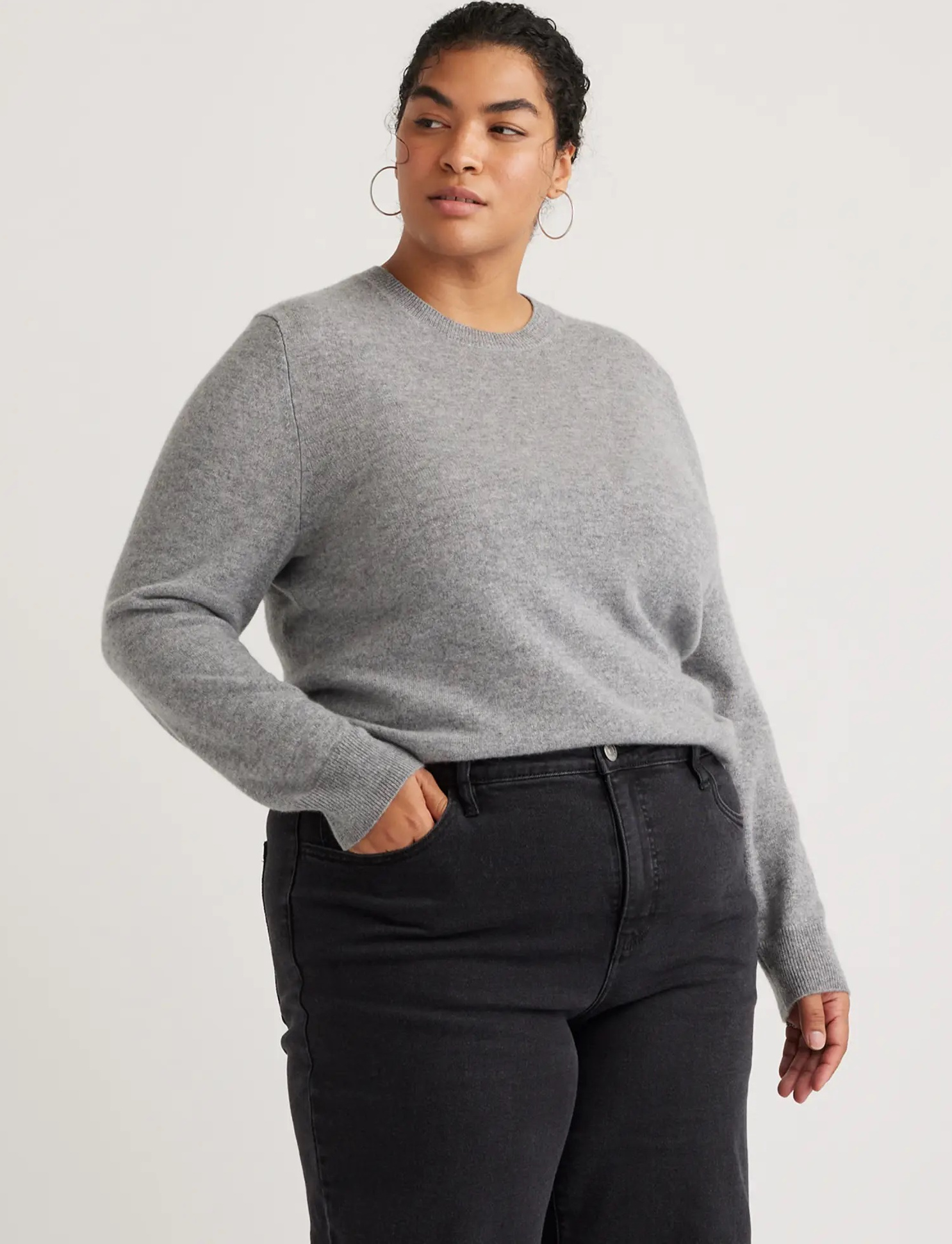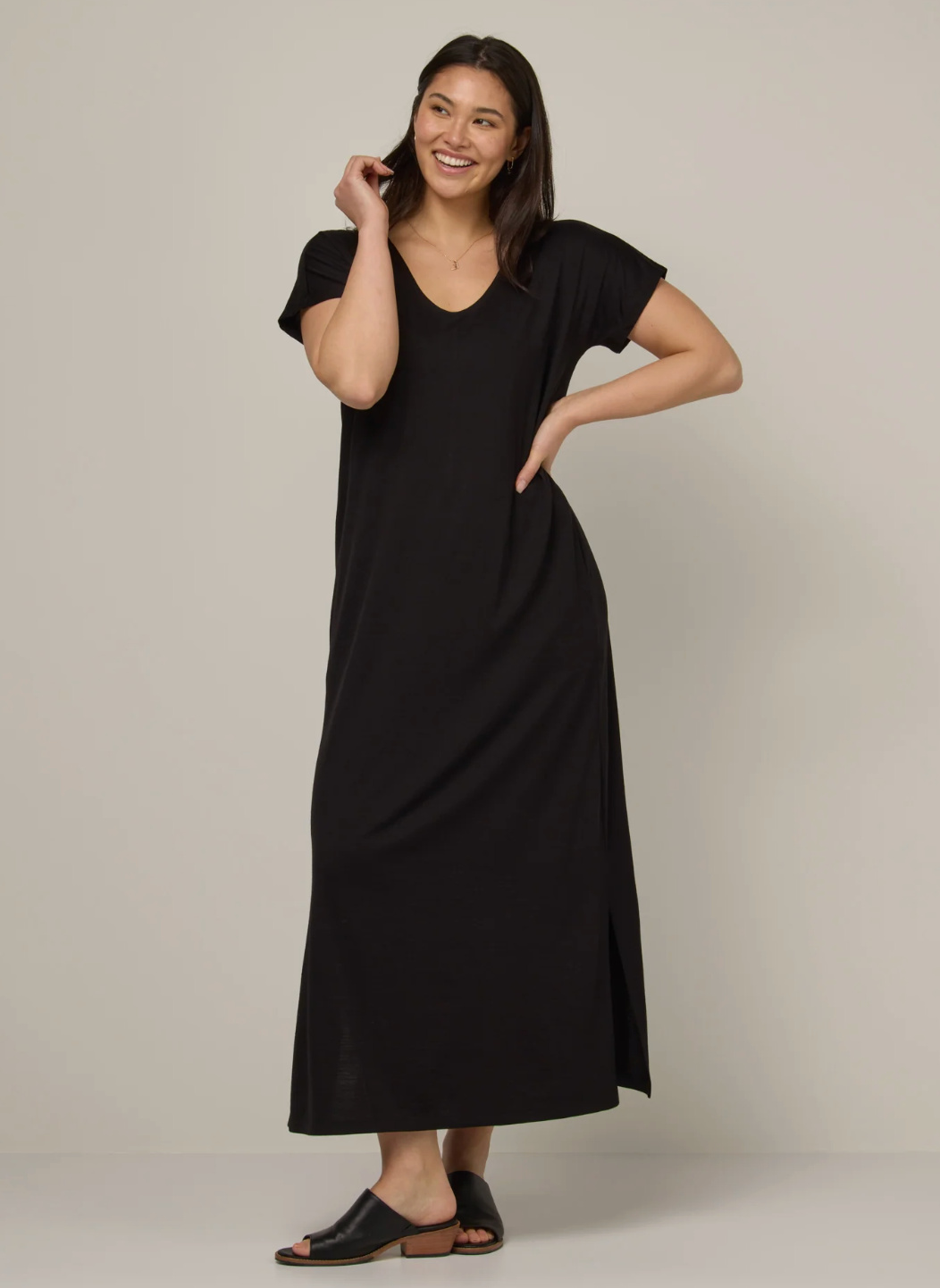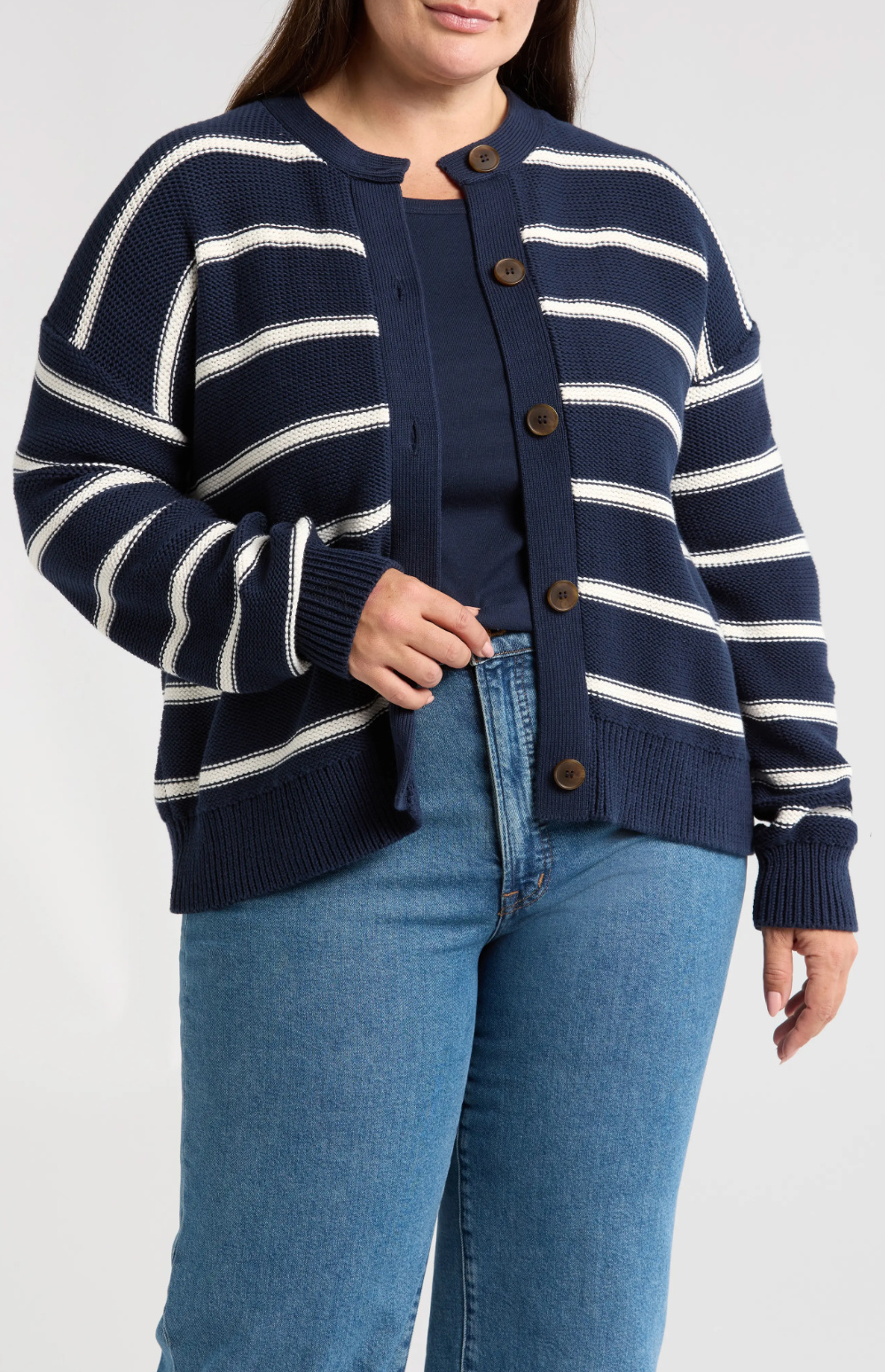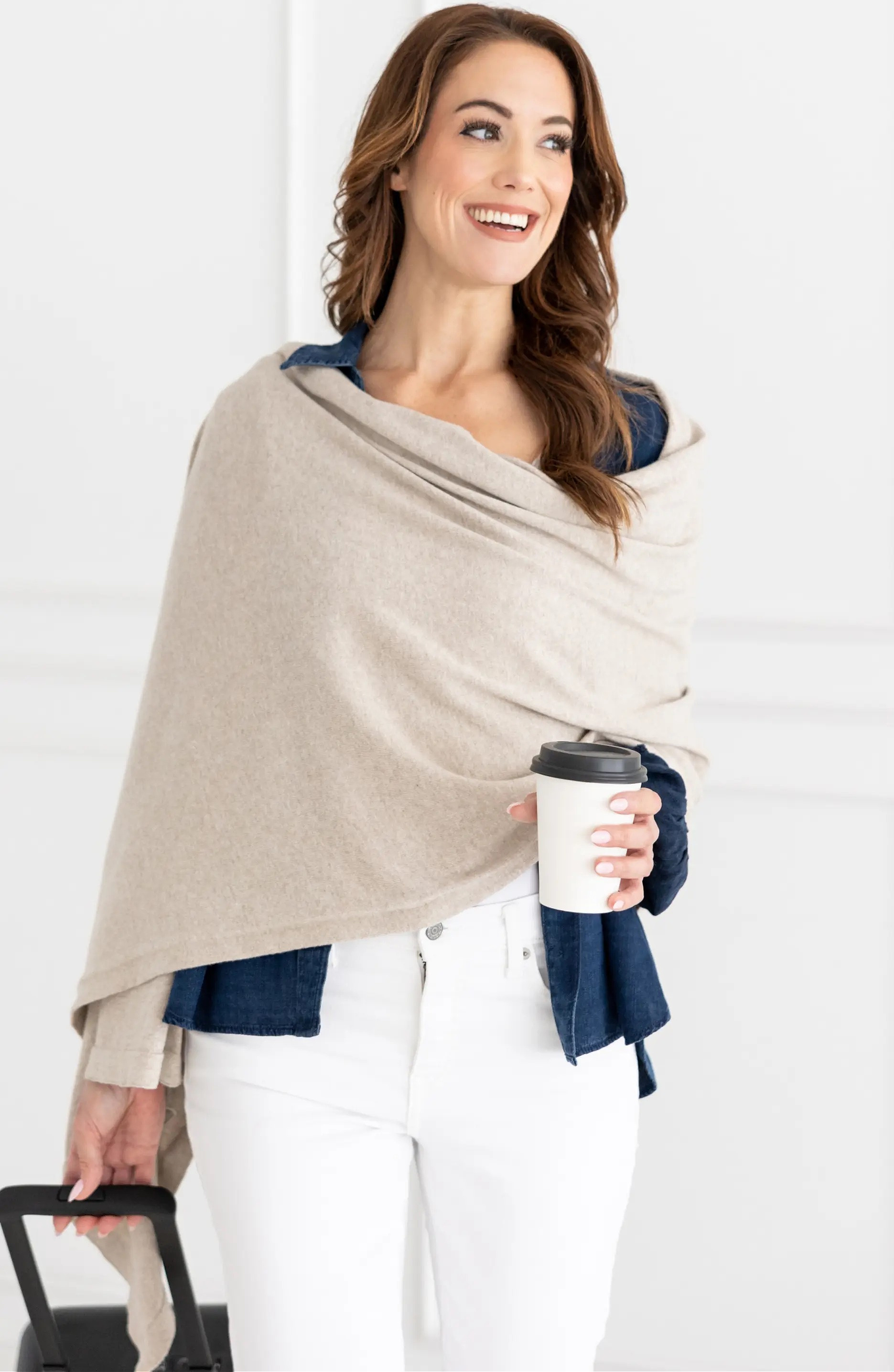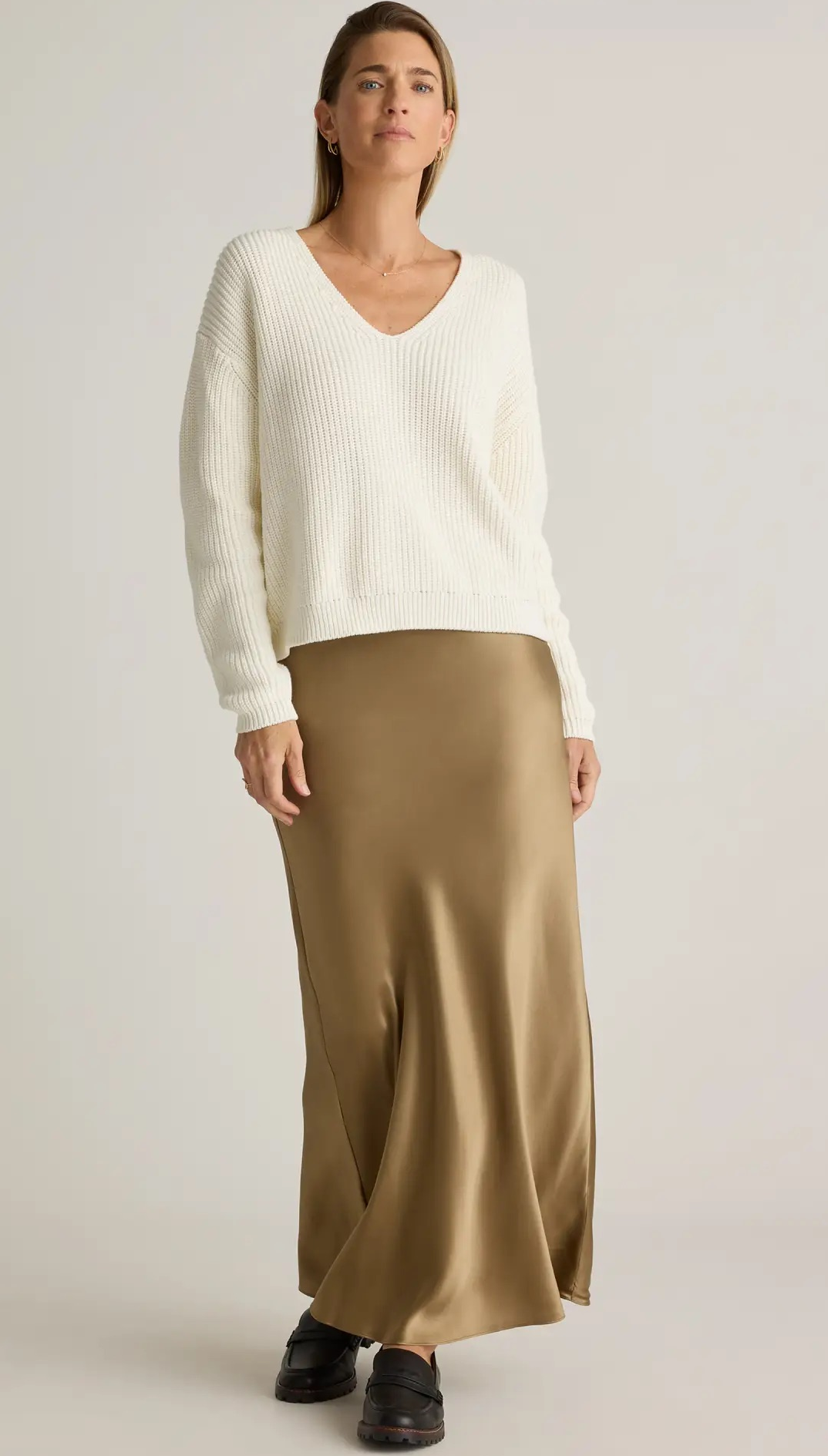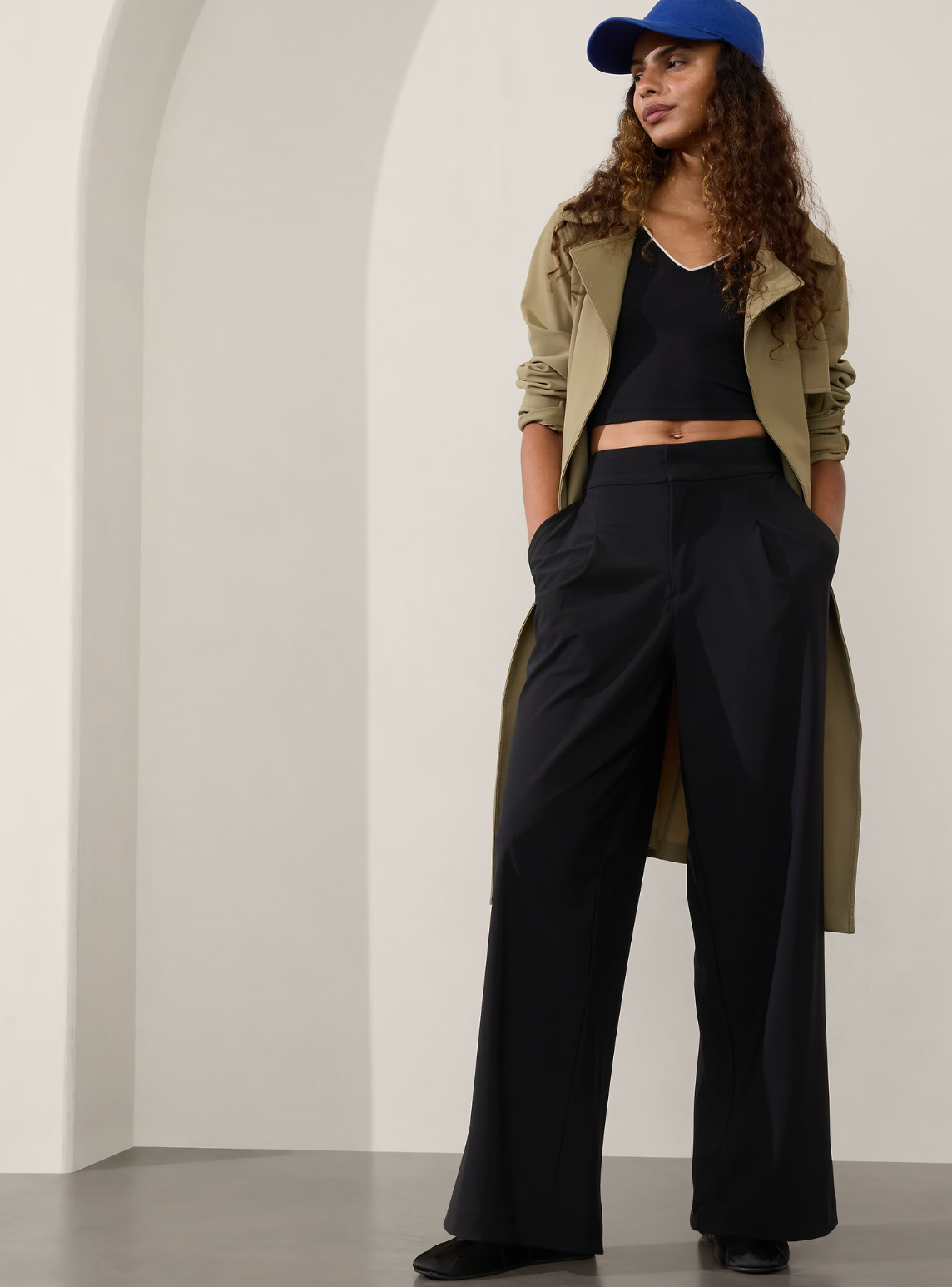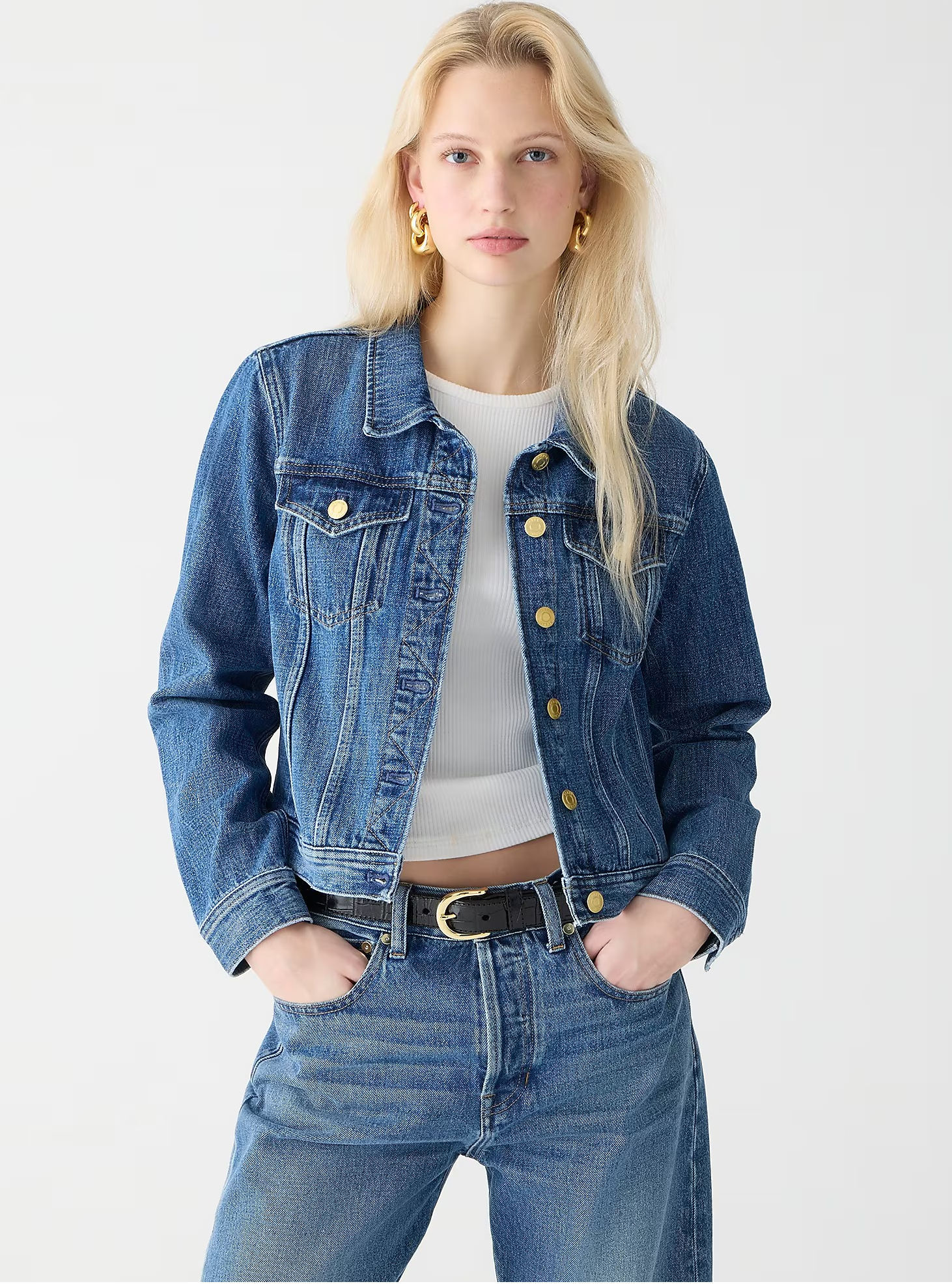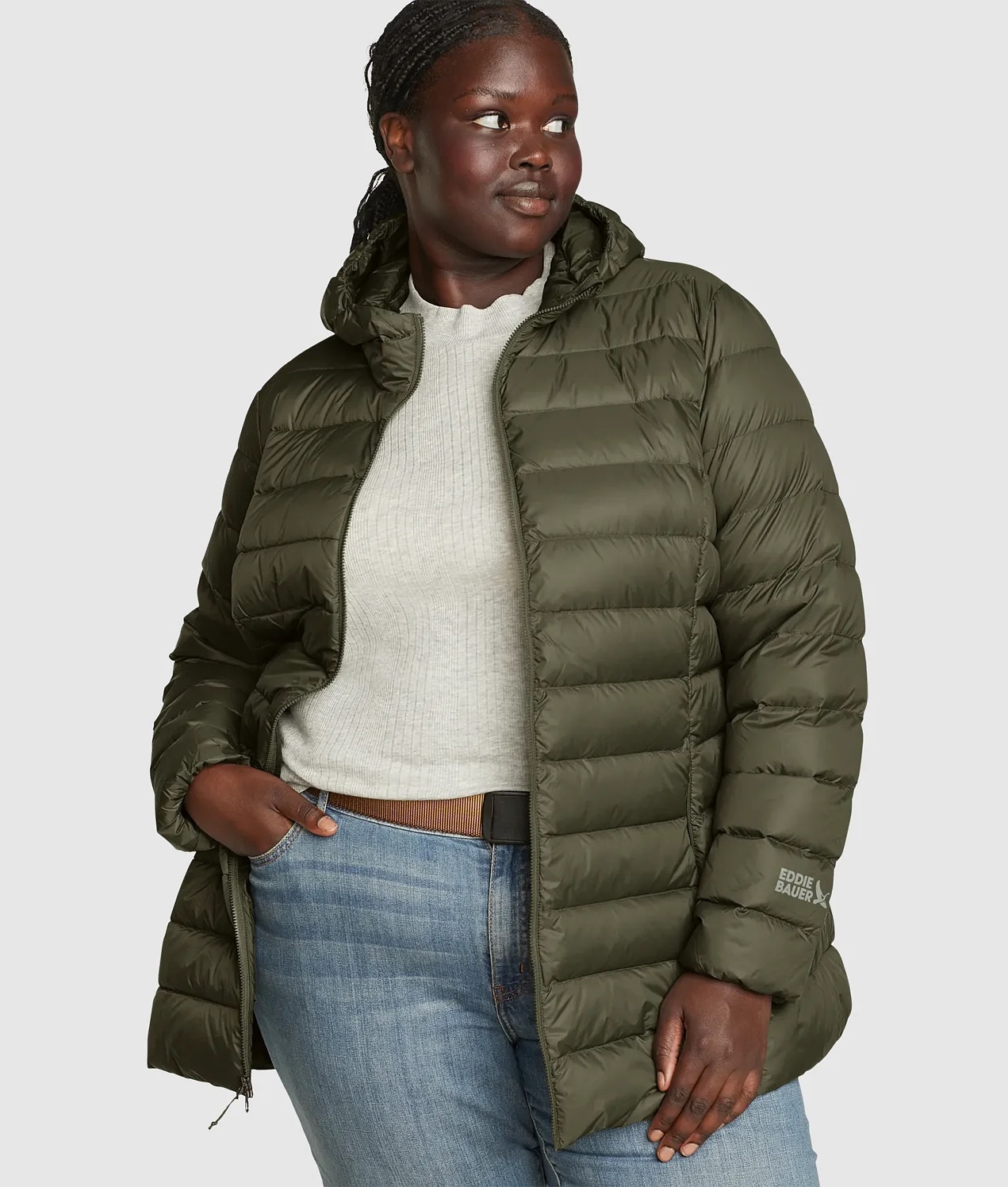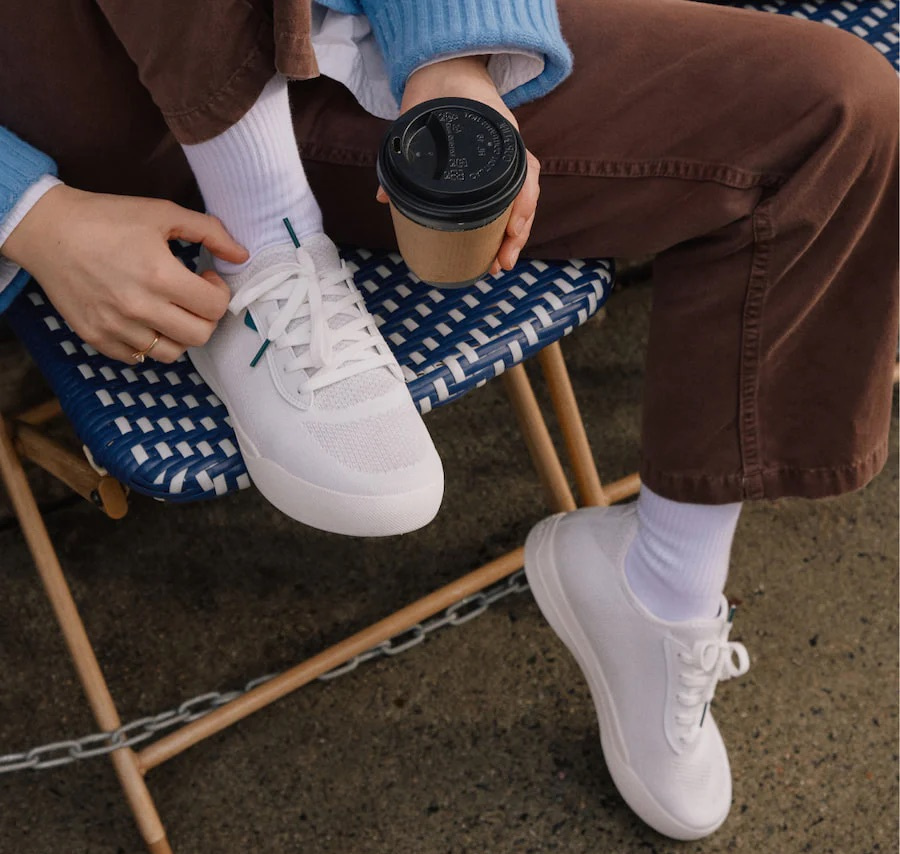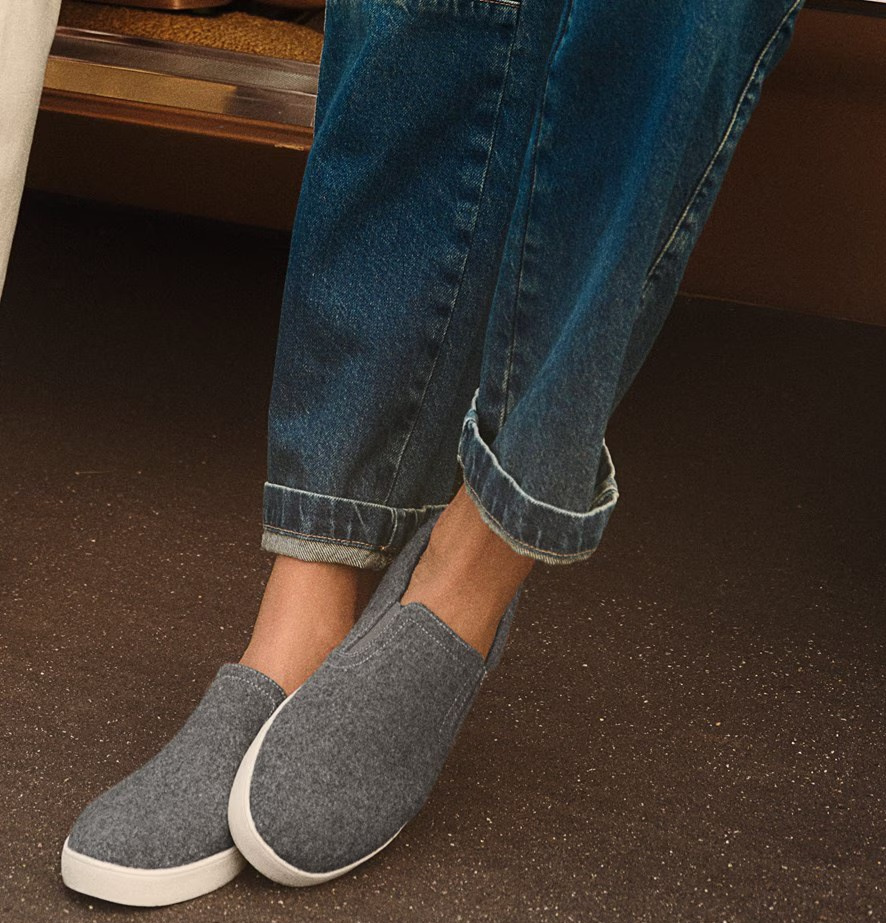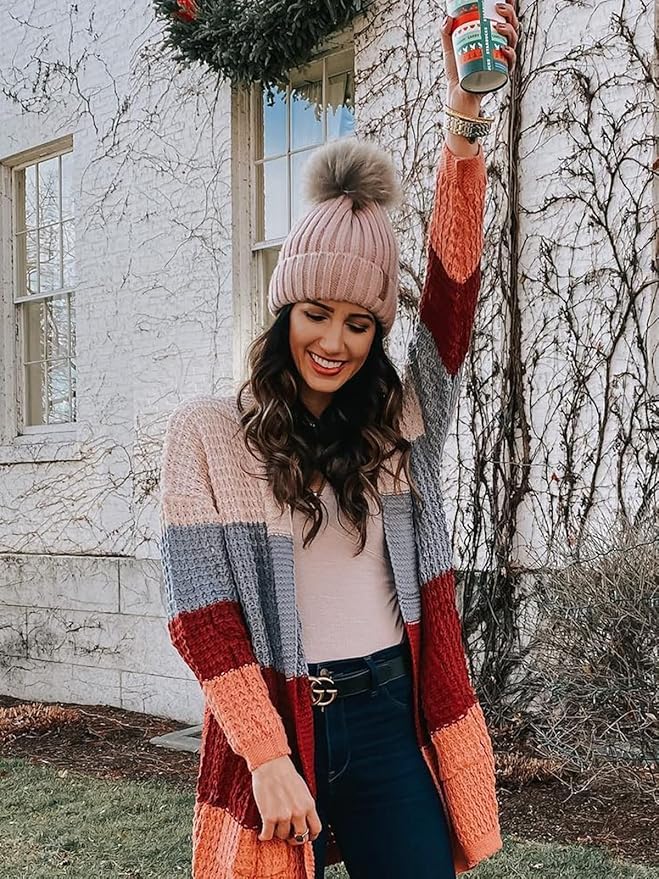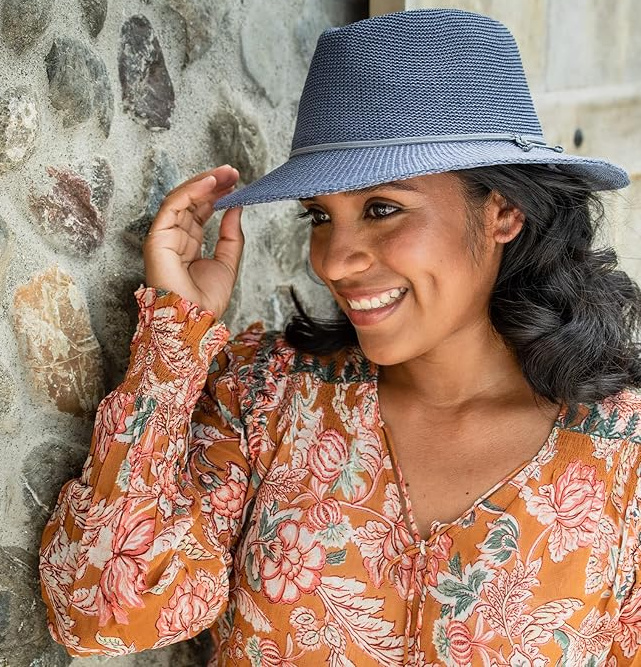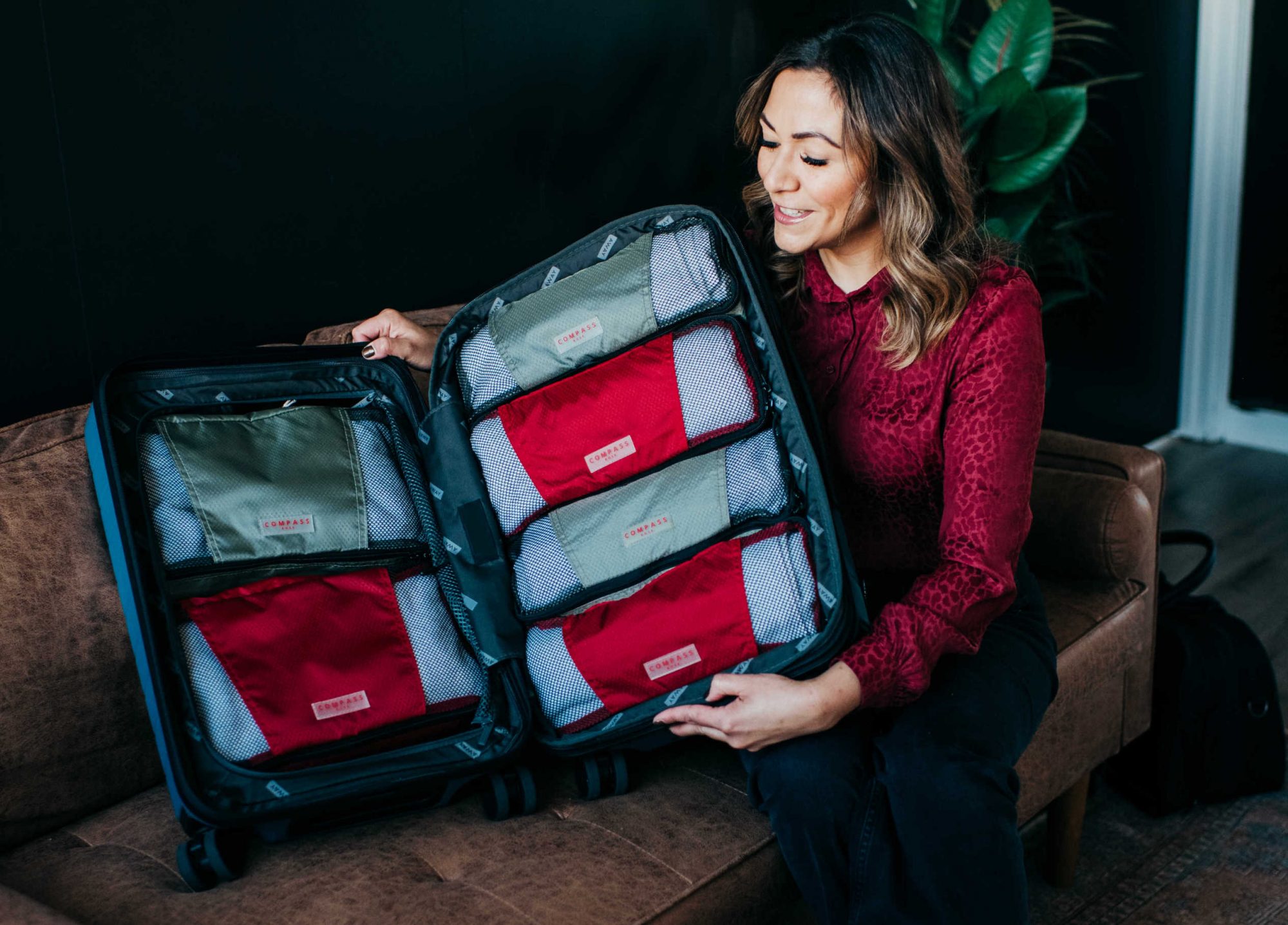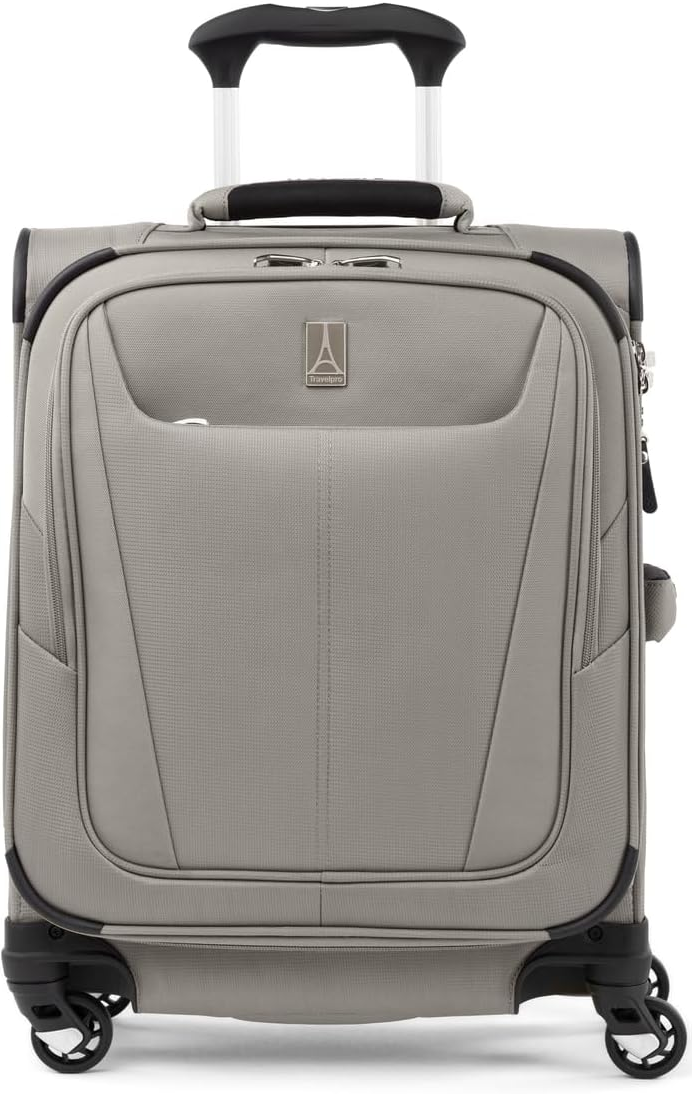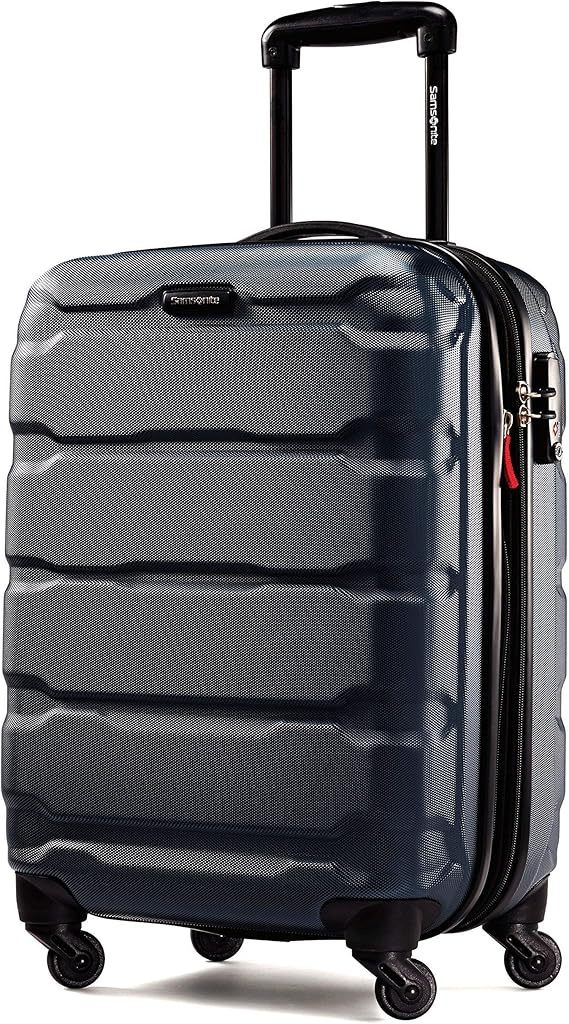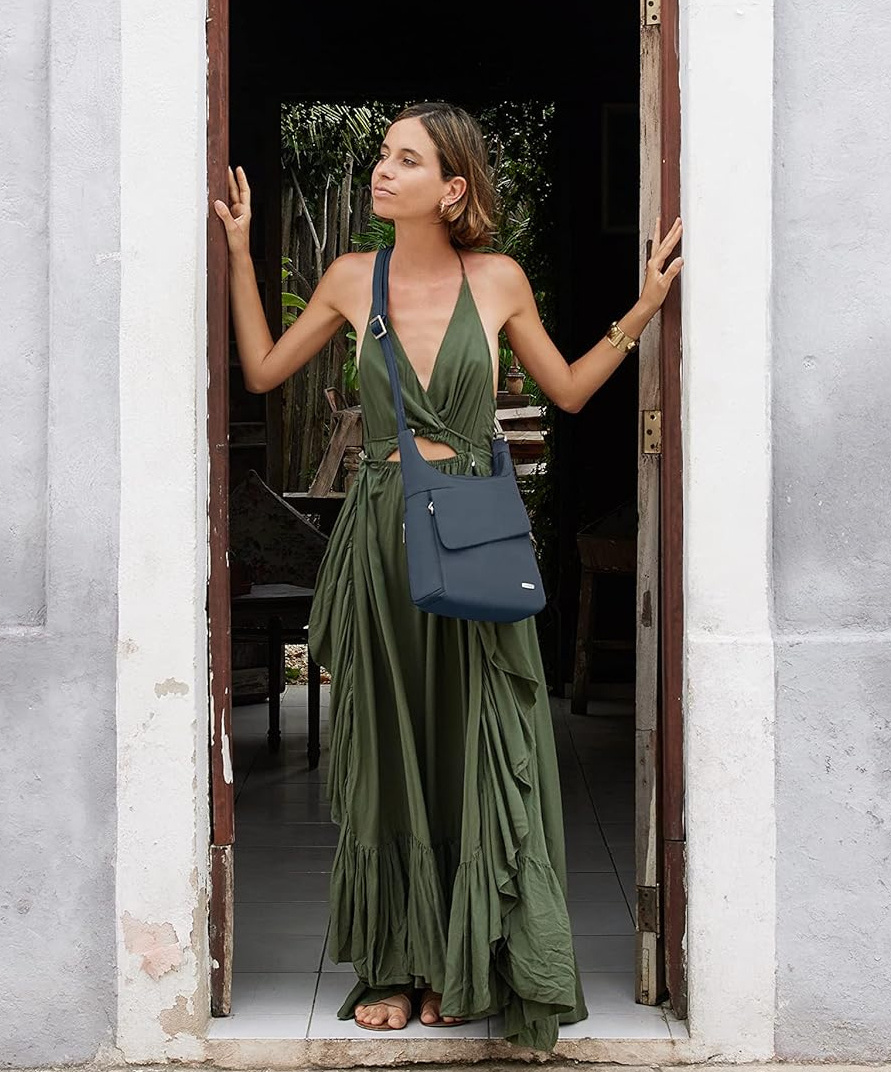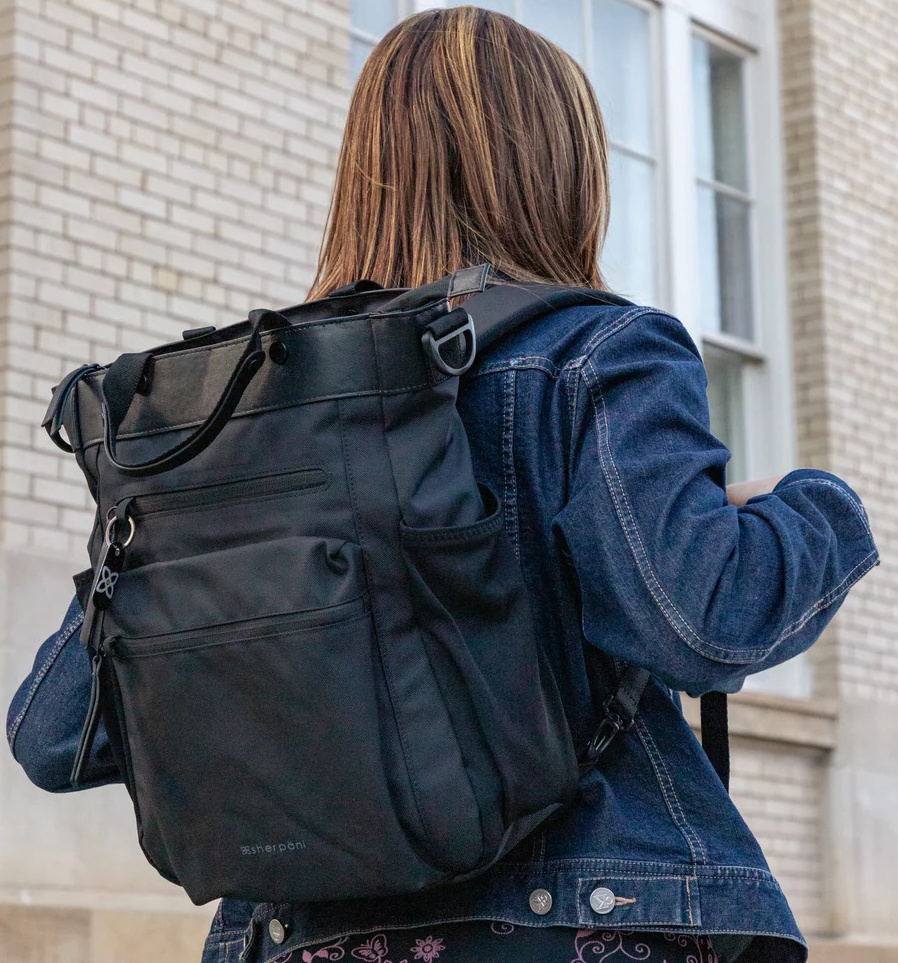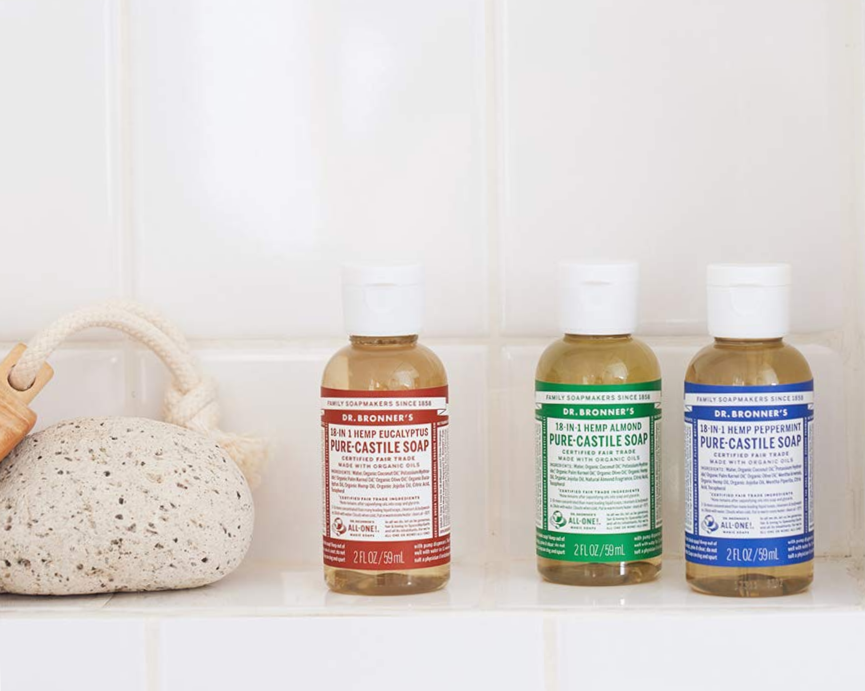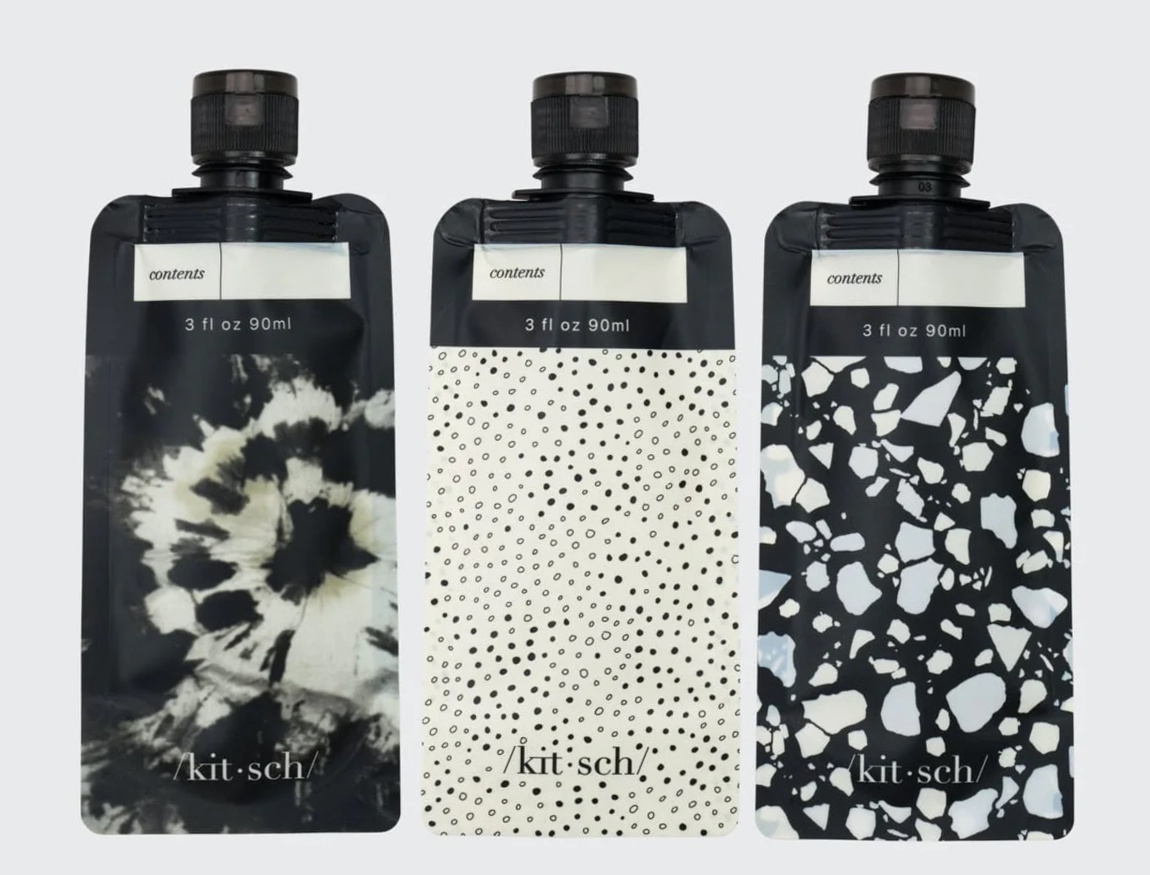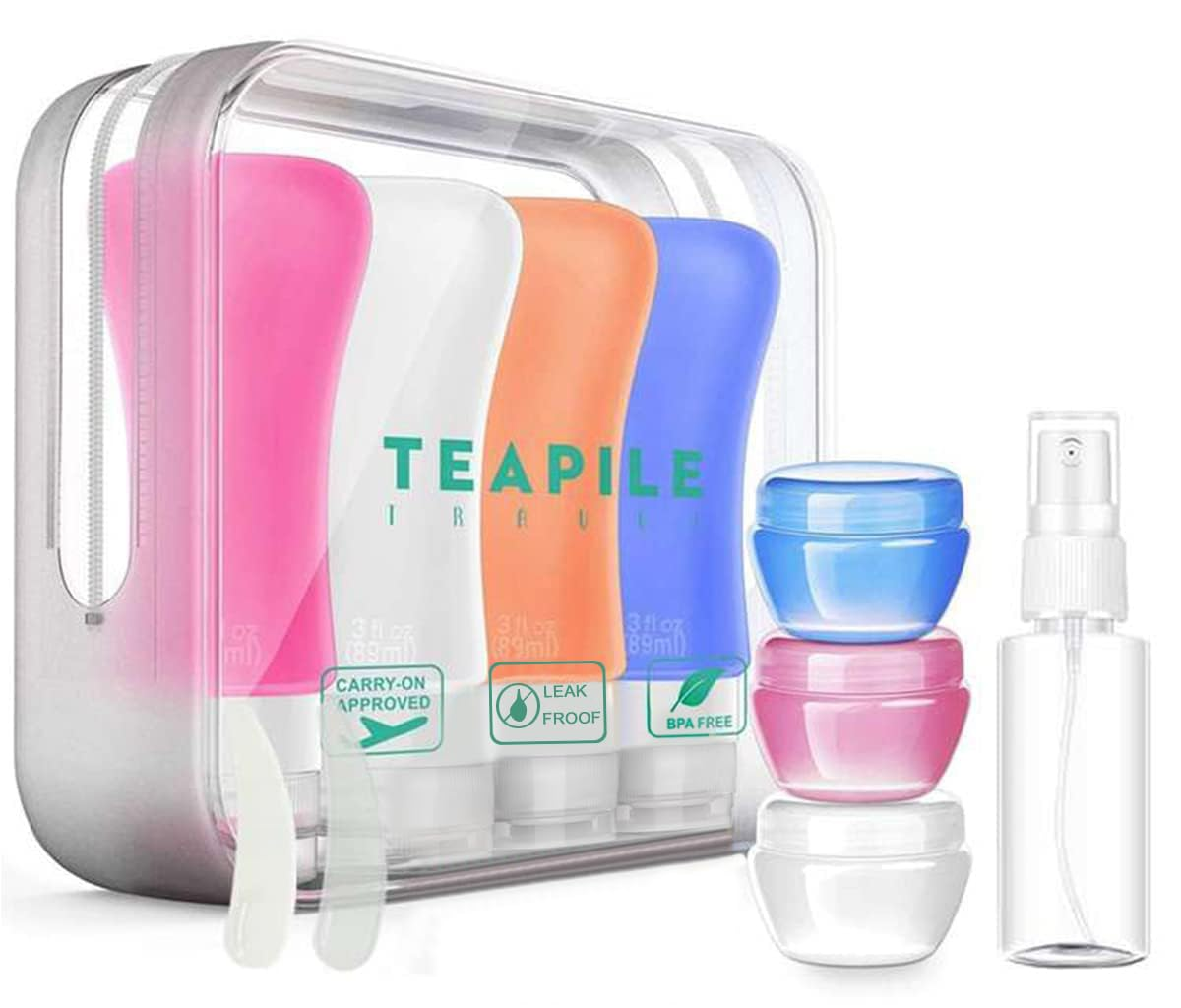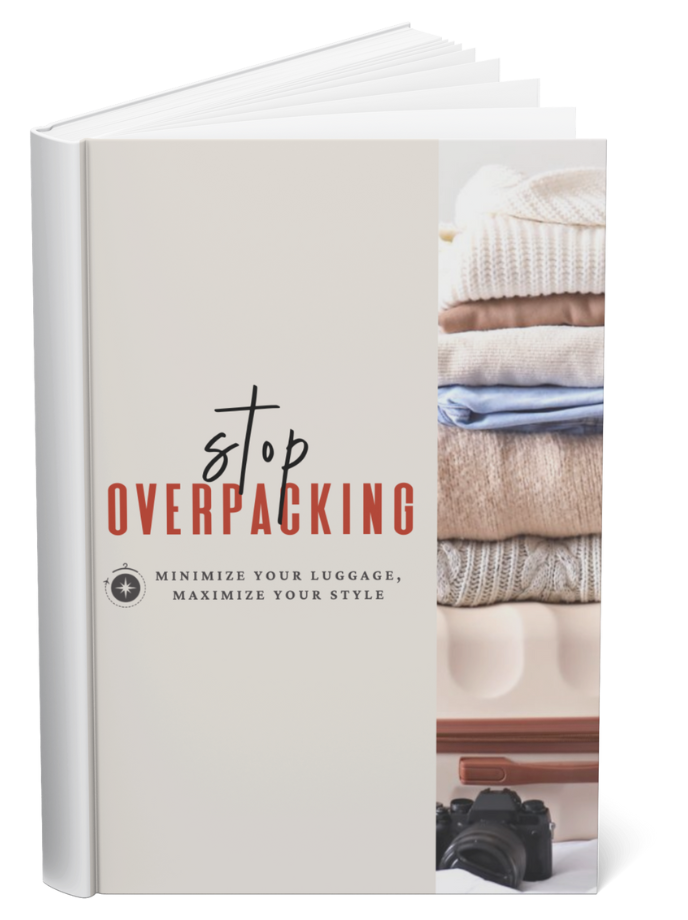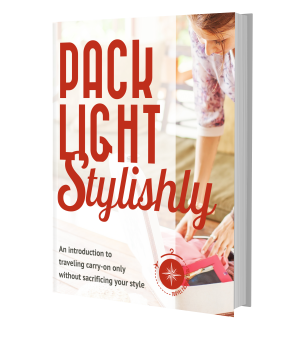10 STEPS TO PACKING FOR MIXED WEATHER
To help simplify the packing process, we’ve created this 10 step packing guide for a trip with mixed weather. Make this
your first stop when planning your next trip. And don’t forget to download your free packing checklist!
How Do I Pack for a Trip With Hot and Cold Weather?
One of the most popular topics in the Travel Fashion Girl Facebook Group is about traveling in mixed weather. How does someone pack for both hot AND cold destinations on the same trip?
Traveling between two climates happens more frequently than you’d think. Sometimes, we visit two different countries or even varying elevations in the same destination. Another example is when your home country is cold, but the destination where you’re traveling is warm.
To help you with this challenging topic, we’ve put together a few tricks to pack for unpredictable weather. Follow these helpful tips!
Sign up for Travel Fashion Girl’s monthly newsletter and get instant access to free packing templates, downloadable checklists, ebooks, and more!
The light yet warmth of cashmere is highly recommended for travel and popular with readers, especially this Quince cashmere crewneck sweater!
STEP 1 – Choose the Right Fabrics
When planning a mixed-weather trip, keep fabrics in mind– they’re key to helping you stay warm or fresh while also packing light.
Avoid choosing clothing items with bulky fabric. For cold climates, avoid thick sweaters and choose lighter materials that offer maximum warmth yet take up minimal space.
The Wool& Freya Maxi Dress is super lightweight and wrinkle resistant, so it won’t take up space in your suitcase!
Likewise, for warm weather, you don’t want to pack a heavy maxi dress with layers of fabric for your warm weather clothing because you’ll take up much needed space. Instead, choose a lightweight, airy dress or maxi skirt.
Let’s cover the best fabrics for mixed weather:
- Cashmere or merino wool – There are jackets made of both, but don’t discount cardigans or sweaters, as they make terrific layering pieces. Alpaca is another fabric that’s soft and fairly lightweight.
- Cotton – A solid fabric that can be warm when layered or lightweight when worn alone.
- Denim – Jean jackets are now so light that putting on a hoodie or sweatshirt underneath can add instant coziness.
- Linen – If you’re planning to be in a very hot place packing some linen pieces which are breathable and light to pack and can be layered. Check out our guide to linen for more information!
- Nylon or polyester – Ideal for rain jackets, which are essential to pack for any potential showers.
- Technical fabrics – moisture wicking shirts and dresses are made of special fabric that allows you stay comfortable in the heat, but they can be layered with warmer items, too.
- Fleece – Not only is fleece a fantastic lightweight, durable fabric, but it’s also awesome for cooler temperatures and everyday adventures; these are just what you need as the seasons change!
Be sure to choose quality items for cold climates, this allows you to avoid packing bulky clothing and be able to pack light.
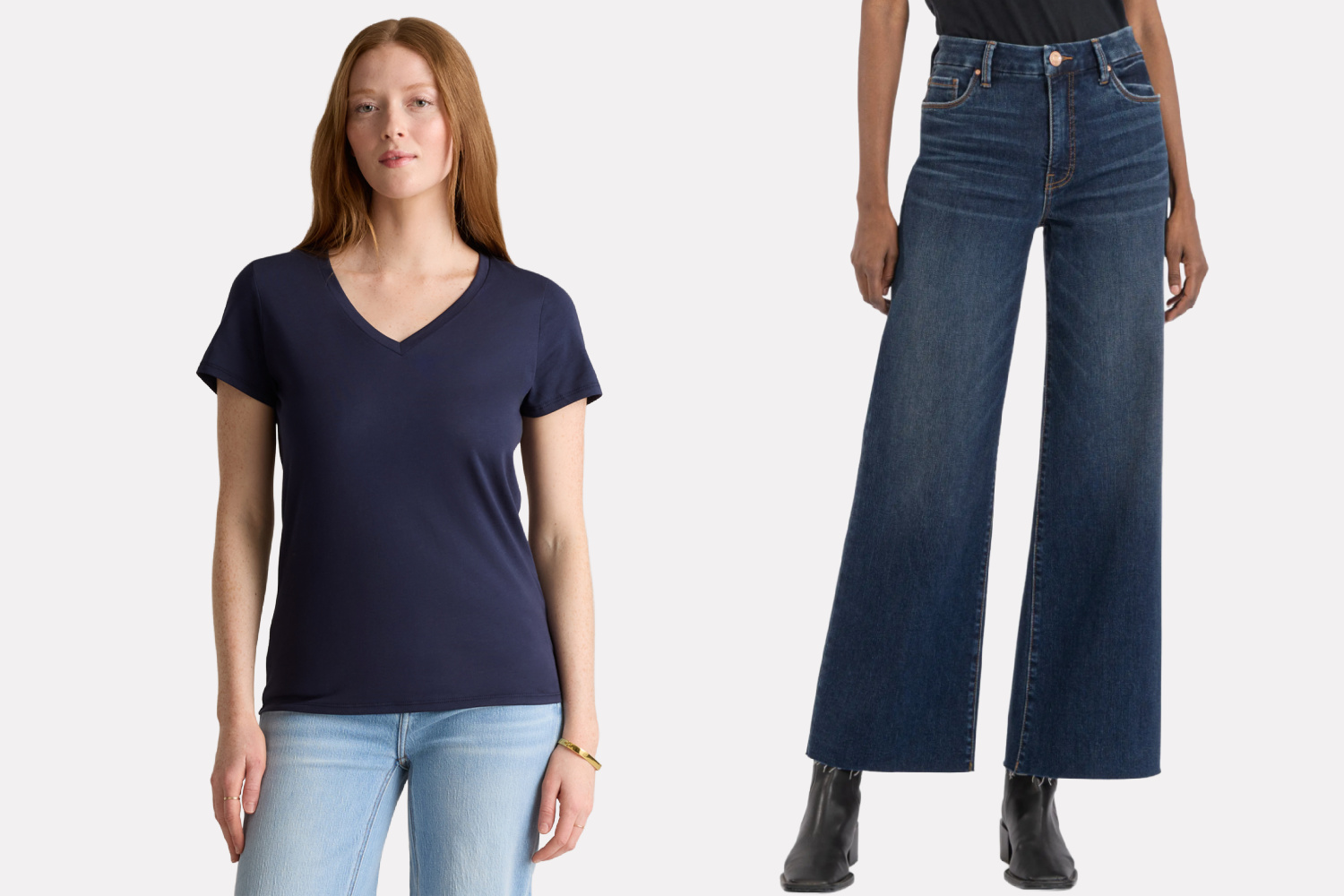
Choose versatile items for warm and cold climates, like this Quince Cotton Modal V Neck tee and these KUT From The Kloth jeans. These can easily be layered—pair the tee with a sweater for cooler weather, and add thermal underwear beneath the jeans for extra warmth when needed!
STEP 2 – Create a Mixed Weather Capsule Wardrobe
Now that you have an idea of what fabrics work well for mixed weather, it’s time to create a capsule wardrobe. A capsule wardrobe (or a “capsule”) is a snippet of the clothing in your closet featuring items that are interchangeable and can be mixed and matched to create various outfits. Read our Pack Light Stylishly ebook to learn more about capsules.
The actual quantity of items in a capsule varies. Because capsule wardrobes are for travel, we focus on bringing just the essentials – about 10 clothing items minimum, 15 maximum.
In some cases some women may only need 6 items. Or for example, you might want to bring more clothing to account for the fluctuations in weather. Therefore 15 pieces of clothes would be sufficient.
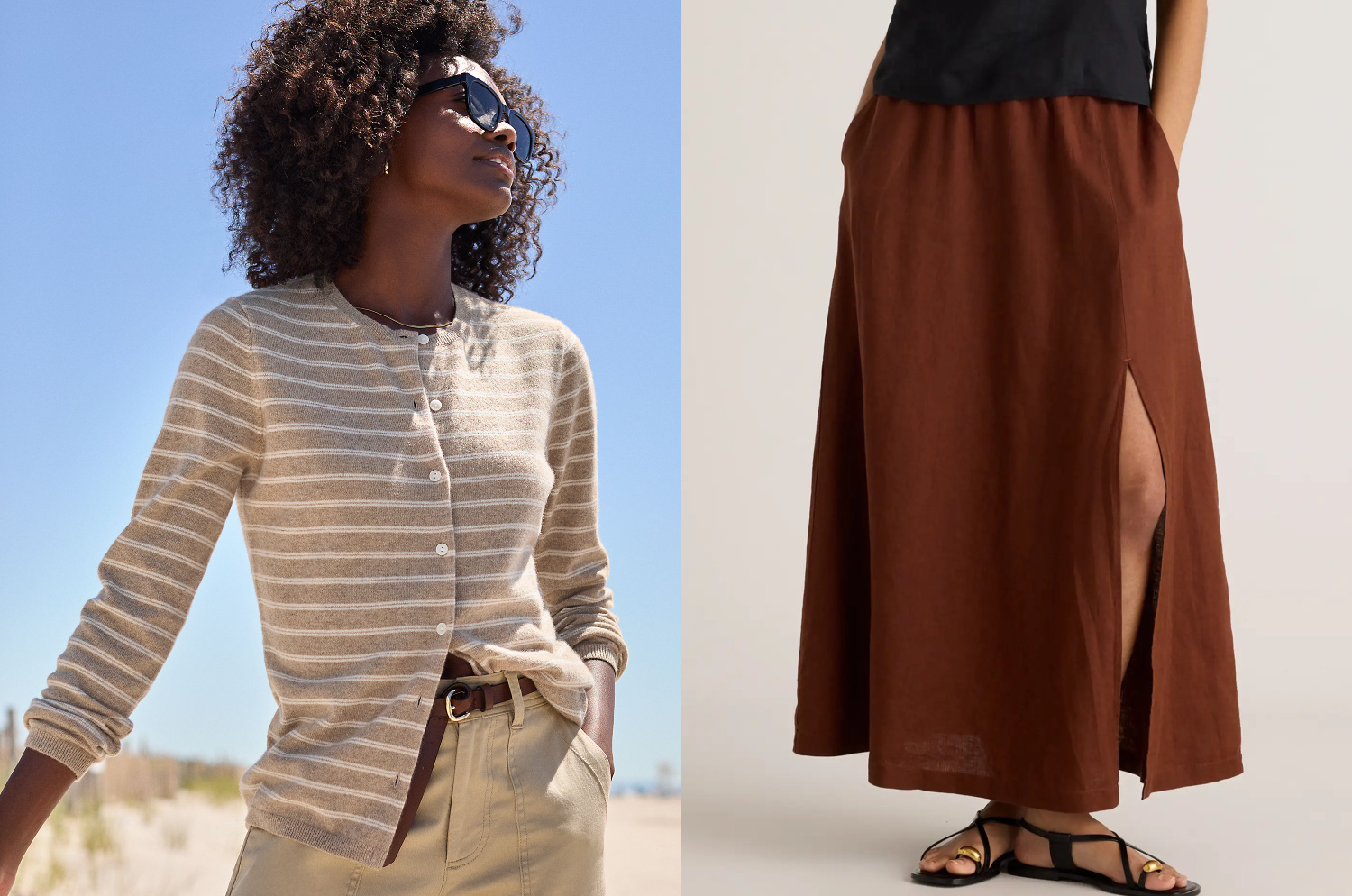
Think about what items can mix and match and go together when the weather changes. This Quince linen skirt is excellent in hotter weather but could be layered with tights and long boots, while the Lands’ End cardigan can go over a top in both hot and warm climates.
You can also watch my full video on how to pack for mixed weather, which is below.
Learn how to master the art of packing for different climates in this video!
For mixed weather packing planning, always check the forecast first! Use an app like Weather.com to ensure you’ll have an idea what to expect at each location.
To determine what to bring, think about how many days you will be in warm vs. cooler weather. For example, say you were planning a 10-day trip and will be spending 7 days in the cold and 3 days in warm weather, plan for 70% of your travel wardrobe to be for cold and 30% to be for the heat.
Overall, the objective is to pack sufficient clothes for all weather conditions, but not to overpack, so you can still manage carry-on travel. Check out this ebook which shows you specific packing modules on traveling in different climates.
Use one of these international packing lists to find clothing ideas to dress appropriately for your destination then use the guidelines from TFG’s Signature Packing Lists to help you customize your travel wardrobe.
For an ultimate layer piece, cardigans are the best! This Caslon Pima cotton cardigan is a reader favorite from way back and continues to be updated yearly!
STEP 3 – Layer Your Tops
Now that you’re feeling comfortable with creating a capsule wardrobe for mixed weather, one of the biggest secrets to this kind of trip is to layer, layer, layer! That means you can use the warm items to layer of the summer items in your capsule and eliminate extraneous clothing you don’t need.
When it comes to your tops, they’re very easy to layer, by adding something and then removing it when it gets hot. Layering is good for mid-season locations which is another reason why it’s wise to make sure each item can mix and match with the rest in your capsule wardrobe.
Another excellent layering top is a long sleeve, and the Land’s End Relaxed Supima Cotton Long Sleeve Crew Neck T-Shirt is one of a top seller for TFGs to stay cozy!
Some of the best layers for tops are long sleeve t-shirts, cardigans, hoodies, and sweatshirts. They allow for flexibility so you adjust to the climate you’ll be traveling in.
Add sweaters into this mix as they’re endlessly versatile! Read our ultimate guide on sweaters to learn how to choose the best one and what types work best for warmth.
For lighter weather, opt for short sleeve tees, in either black or white, tank tops, and even linen shirts and then use those aforementioned heavier layers on top!
The Zestt Organics Dreamsoft Travel Scarf is comfy but also flattering and cute! It’s the perfect companion for staying warm in the evenings or wrapping up in on a flight while still looking polished!
Another good layering option are wraps. Not only are they super chic, but they’re also a style workhorse for travelers. You can snuggle up in one by a crackling fire, layer it underneath a jacket, or wear it around your neck when it’s chilly outside.
Also be aware you might encounter different weather conditions even in the same destination. While it might be warm during your day of excursions, the temperatures might drop at night, so always having a layering piece is helpful.
This Quince silk maxi skirt can work in both hot and cold weather, because iut can be worn with sandals and then shifted to tights and covers shoes!
STEP 4 – Layer Your Bottoms
Another clothing item that you can layer up is your bottoms!
For milder weather locations, you may be able to wear pants or skirts solo, but there are layering options as you move to colder weather.
For example, aim for a flowy maxi or midi skirt, lightweight cropped pants, or midi and maxi dresses. The best way to layer as you move into a colder destination is to wear bike shorts or tights underneath.
Versatile pants are a must for different climates; for example, these Athleta Pinnacle High Rise Trouser are light and breathable, but you could layer with leggings or thermals underneath to warm them up!
For colder climates, lightweight jeans, ponte pants, faux leather leggings, or wide leg pants offer more coverage and slightly heavier material. The best way to layer is to add leggings, tights, or even thermal underwear if you’re going to really chilly places.
Leggings are also great for under dresses, too!
The top-selling J.Crew Denim Jacket is a chic classic with a comfortable stretch and makes a great layering piece for chillier nights or breezy days.
STEP 5 – Add the Right Layering Jacket
Another essential key to packing for mixed weather is the jacket you choose. To ensure you’re packing light, avoid heavy jackets. Explore this ultimate guide to winter jackets to ensure you’re always choosing the right one for your trip!
If a stop on your itinerary is in a climate that requires a jacket but is not freezing temperatures, opt for thinner layers like a jean jacket, travel blazer, fleece jacket, vest, trench coat or a leather jacket.
And when layering, you can add merino wool tees, hoodies, or sweaters, or sweatshirts beneath these lighter jackets.
The best way to pack light for wintry conditions is to take a packable down jacket like this Eddie Bauer CirrusLite Parka. Down is often the warmest and not heavy.
While it seems attractive to pack a heavy coat when heading to really cold destinations, avoid bringing a thick jacket when possible and try to aim for a packable down jacket or a down parka. Or aim for a non-down parka or jacket that’s lightweight. For really wet weather, pack a waterproof rain jacket, which can also be layered, too.
Some readers do swear by wool coats, but if you do take one, it’s recommended that you wear it on the airplane and stow it away when not in use.
No matter what, always carry two quality outerwear items that can be worn together in the cold. Depending on your trip, this should consist of one piece that acts as an outer layer to offer protection from wind and rain and one middle layer to insulate and provide warmth.
To delve even deeper into how to pack for mixed weather, read this article that covers an example capsule wardrobe!
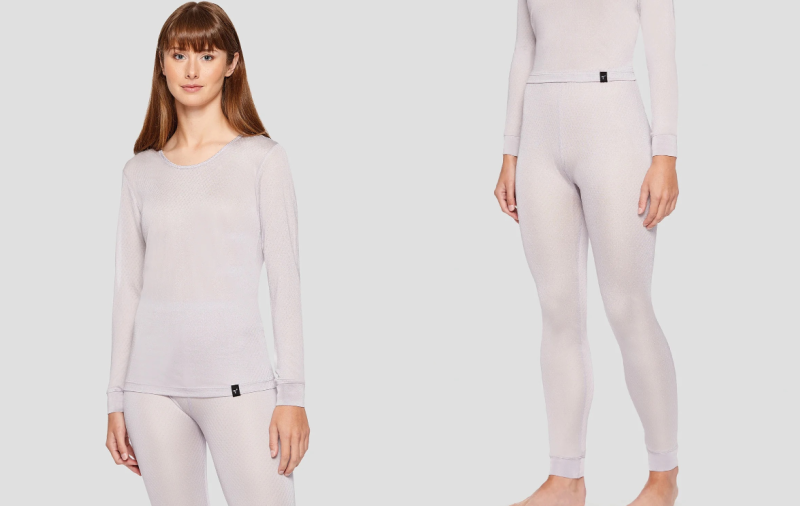
Silk thermals like the Terramar Thermasilk Pointelle Shirt and Pointelle Pants are quite light to wear and also will regulate your body temperature to keep your warm.
STEP 6 – Wear Thermals in Cold Climates
When it comes to packing light for a mixed trip, one of the most vital ways to do this is by wearing thermals underneath your clothing. There is one major difference between being at home in the winter and traveling when it’s cold: the amount of time you’ll spend outdoors.
Thermals are lightweight but highly effective layers that keep your body heated and insulated so you won’t lose any warmth, yet they aren’t bulky Don’t skip these! If you’re not used to the climate, add additional layers until you feel warm.
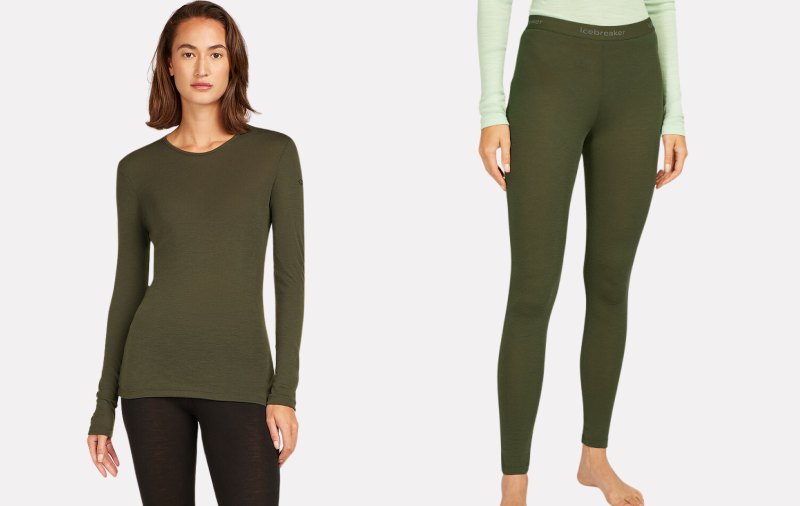
Some of the best materials for long underwear is merino wool, and the Icebreaker thermal top and thermal bottoms are not heavy but will keep you toasty warm!
There are different types of thermals out there; one highly popular one are silk thermals, which are soft, light, and thermo-regulating, and here is a list of the warmest thermal underwear.
Knowing how to pack for cold weather travel can be quite daunting, especially if you want to pack light. To help you make the most of your winter gear and limited luggage space, I’ve created this easy three-part guide on how to pack for cold weather.
Tip:If you find that will need warmer clothing as you travel, you can just buy a few pieces at your destination, including a hat and gloves. For example, it’s common to see many backpackers in Peru wearing traditional Alpaca sweaters/hoodies/gloves/hats because they may not have had enough warm clothing. However, it’s inexpensive to buy a few items that you’ll use daily and will also make a great souvenir!
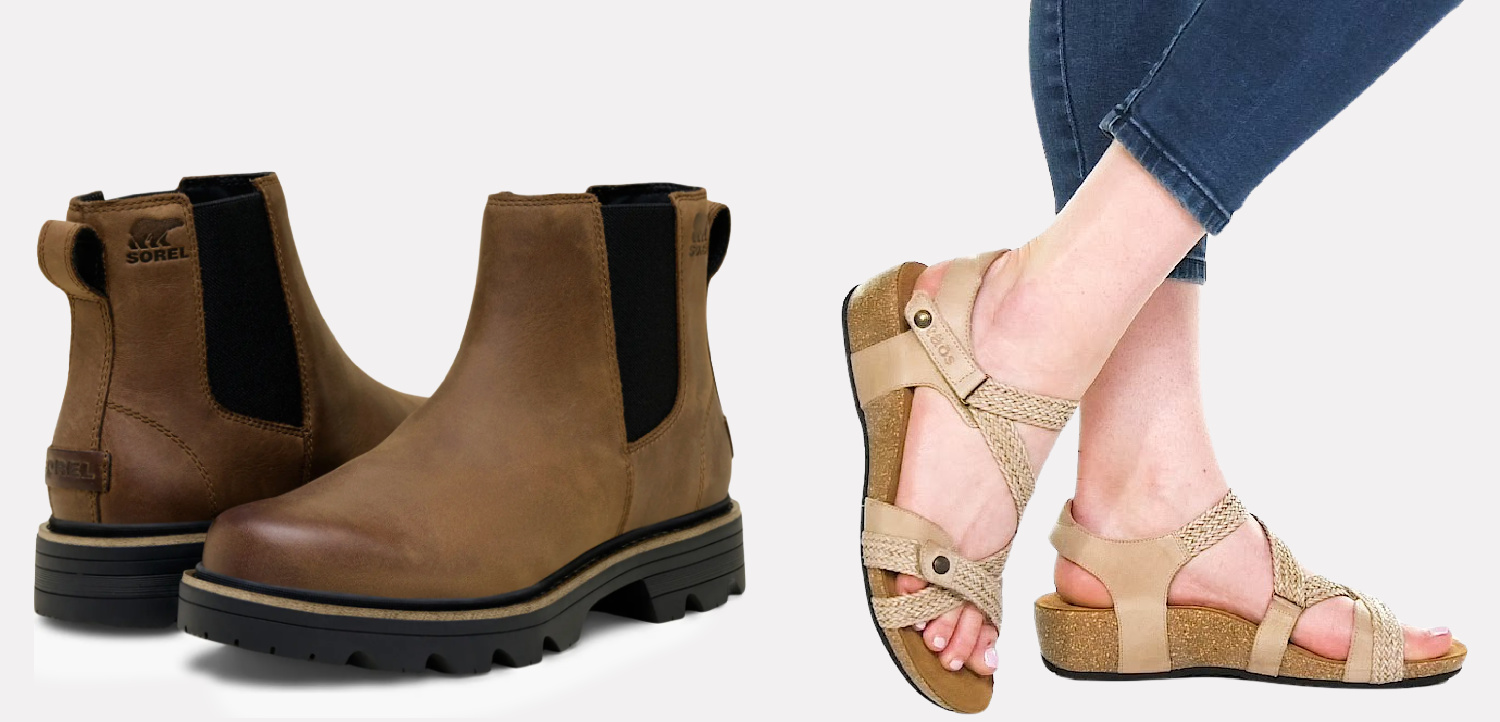
A good pairing for cold and warm weather are these Sorel waterproof boots, and the Taos Trulie sandals are solid for hot, humid places.
STEP 7 – Pack the Right Shoes
Don’t overpack shoes. Choose one pair of shoes for sightseeing in the cold and then one pair of shoes for sightseeing in the heat.
In general, emply the 3-Shoe Rule when it comes to packing shoes, and this rule also applies to mixed weather trips.
Why 3 pairs, and not more or less? The three-shoe rule stems from having no more or less than what’s needed for any given trip. This specific number is the right amount to help prevent overpacking, and each shoe plays a role in covering all the potential activities you’d likely have planned.
The 3 shoes are:
Sightseeing Shoes – Your “sightseeing” shoes are the pair you’ll be wearing for the majority of your trip. Choose a quality, comfortable pair of walking shoes with solid support. Since you’ll be wearing them most of the time, they need to be supportive, not restrictive or hurt. They should be able to go with the majority of your outfits.
Activity Shoes – An activity shoe is what you pack for a specific activity you have planned for a trip. Whether it’s hiking, dancing, working out, or whatever it might be, this is a shoe you likely wouldn’t wear all the time but just for that chosen activity.
“Wild” Card Shoes – Your third pair of shoes is up to you! Choose a third pair based on your trip needs. If f you’re experiencing two different climates on your trip, choose a second “sightseeing” shoe to fit the changing environment.
For example, you might pack leather sneakers as your sightseeing shoes, hiking sandals for another leg of your trip, and then waterproof boots as your “wild’ card shoes for colder weather.
Highly popular, the Vessi waterproof sneakers can do double duty by remaining dry in wet climates, but they are also fashionable for drier places where you’ll do a lot of walking.
For chilly temperatures, these are the best shoe options:
- Loafers (for early fall)
- Tennis Shoes and Casual Sneakers (for early fall)
- Waterproof Sneakers (for fall and early winter)
- Chelsea Ankle Boots
- Combat Boots
- Moto Boots
- Black Ankle Boots
- Mid-Calf Boots
- Waterproof Snow Boots
- Waterproof Autumn Boots
- Waterproof Winter Boots
- Hiking Boots (for active vacations)
- Comfortable Long Boots, Long Brown Boots, and Long Wide Calf Boots
- Rubber Rain Boots and Duck Boots (for short bouts of walking or severe weather)
The bestselling Dr. Scholl’s Madison slip on sneakers are a great in-between choice that offers foot coverage yet isn’t too heavy for warmer destinations.
For warmer temperatures, these are the best shoe options:
- Black Sandals, Tan Sandals, White Sandals, or ALL the sandals our readers love
- Beach Sandals
- Gladiator Sandals and Snakeskin Sandals (fun fashion picks)
- Flip-flops and Beach Sandals (for resort or beach trips)
- Slides and Slide Wedges (for short bouts of walking)
- Wedge Sandals
- Ballet Flats
- Slip-on Sneakers
- Espadrilles
- Mary Janes
- White Sneakers
- Black Sneakers
- Fashion Sneakers
- Hiking Sandals (for active vacations)
Note that flats, loafers, wedge sandals, Mary Janes, and espadrilles can be your third wild card shoe,
For more ideas, these are the most cute and comfortable walking shoes and the most comfortable and cute sandals, as recommended by readers!
Read our ultimate guide on choosing the right travel shoes for your trip and the weather!
The Furtalk beanie hat is packable and can be taken out when the cold hits!
STEP 8 – Don’t Forget Proper Accessories
While the main focus should be creating the right mixed weather capsule wardrobe, it can be easy to forget things like accessories. Don’t skip these!
When the weather changes, having a warm hat, gloves, and a scarf adds to layering up when in a wintry or wet cold place.
Able to fit nicely into a suitcase, the very popular Wallaroo Victoria fedora has UPF protection and a robust weave to keep the sun out!
Simultaneously, once you land in a hot place you might want to have a packable sun hat on hand. Just keep it stowed in your suitcase and bring out when you need it. You’d also want sunglasses and sunscreen!
Take a look at our ultimate guide to travel accessories to learn what else you should pack for a mixed weather trip.
Readers swear by the Compass Rose Compression Packing Cubes to organize clothing!
STEP 9 – Use Packing Cubes to Compress Clothing
The best way to handle mixed weather clothing items is to use luggage organizers such as packing cubes to compress clothing which allow optimum use of the space in your luggage, while keeping everything organized and in place during your travels, and making the task of unpacking and repacking simple and stress-free.
Many readers use our Compass Rose Packing Cubes for packing, and they’re now offered in two sizes: slim and medium. The slim size cubes measure 13″ x 5″ x 2.8″, and the medium size cubes measure 2.8″ x 13″ x 8.5″. Both fit an international carry-on suitcase!
The medium size is great for bulkier items or clothes you may want to fold instead of roll. Check out this video on how to organize using packing cubes, it’s incredibly easy!
Watch this packing cubes video tutorial for mixed weather:
Watch this video and learn how to pack for 2 different destinations!
If you’d like more information on packing cubes, check out our ultimate guide to packing cubes and find out why readers swear by them for packing absolutely everything they need for a trip!
The Travelpro Maxlite 19” softside suitcase is a #1 reader fave for its lightness, spinner wheels, and ability to fit everything needed for an adventure!
STEP 10 – Choose the Right Luggage and Personal Item
One of the most important aspects about packing efficiently is using the right suitcase. For a mixed weather adventure, it’s important to choose wisely, and that means having durable luggage to take you between two different climates.
Here are the parameters to choosing luggage:
Size and Weight – For domestic travel, your travel suitcase should measure 22” x 9” x 14” or less. Opt for a carry on no larger than 45” (length + width + height). This is small enough to fit into the overhead compartments on most airlines. As for a checked bag, choose one that’s no larger than 62”, which is standard for most US airlines. Note that US domestic carry on size is larger than European carry on sizing, which is addressed in our airline sizing guide.
Luggage Features – Today’s suitcases come with a wide variety of cool features, such as spinner wheels, telescoping handles, durable zippers, good compartments, and expandability. leep in mind that the more bells and whistles there are, the heavier the bag, which you don’t want when packing for both hot and cold places. If your goal is to pack light, choose a suitcase that weighs less than 5 lb or 2 kg like the ones mentioned in this article.
Safety Features – Most luggage nowadays has built-in TSA locks, but if you want extra security, a trusty external lock is guaranteed to at least slow down a thief or put them off altogether. Many high quality suitcases include a pre-installed tracking device that you would monitor from an app. Or you can use a third-party tracker. The most popular ones are the Apple AirTags and Samsung Galaxy SmartTag for Android phones, but see the full list of the best luggage tags.
Price – Remember that price generally reflects quality. Search around for the best reviews from experienced travelers and opt for a case that suits your style of travel. Many times, expensive bags will include a warranty of some kind; however, these suitcases with a lifetime guarantee are the wisest choice, so your purchase will always have protection.
The very light Samsonite Omni PC 24” is at a light 8.3 lb, yet it can hold all your belongings for a mixed-weather trip!
Besides all the factors to consider when looking to buy luggage, here are some of the best types of suitcases, according to our readers:
- Best International Carry On Luggage – 18-20” is considered the international size, as European airlines like EasyJet or Ryanair have those standards, so be careful and adhere to these guidelines.
- Best Carry On Luggage For Travel – For a domestic carry on, the most common size is 21 -22”. You can travel anywhere with a suitcase this size—here’s a step by step guide to how!
- Best Checked Luggage – The recommended size for a medium checked suitcase is 23–24”, which is perfect for anyone who isn’t quite ready to travel carry on and need just a little extra room. If you’re traveling with another person, it might be a better investment to just take one 25-27″ suitcase for both of you.
- Best Ultra-Lightweight Checked Luggage – If you’re concerned about the weight of a checked suitcase, which is legitimate when it comes to a mixed weather trip, aim for the lightest model you can find—they do exist!
- Best Luggage Sets – A trip with two different weather patterns might involve packing for the whole family, which is where using a luggage set is a sound idea! You can divide up the cold and warm portions of your travels by using a heavier suitcase for winter clothing and the lighter one for warmer weather.
Overall, for mixed weather you want to make sure your suitcase can handle different climates, but also different places. For example, a softside suitcase might be more suitable for Europe, because they can squeeze into smaller spaces, while hardside suitcases might be great for warmer climates due to their durability and they won’t be plagued with grime or dust as much due to the hardshell exterior.
Read our ultimate guide to the best luggage to know all the ins and outs of choosing the right luggage, knowing the best suitcase brands, and seeing our readers’ favorites!
A long time bestseller, the Travelon Anti-Theft Messenger Bag holds a staggering amount, including a water bottle; it’s a great personal bag item with the extra bonus of security features!
A suitcase is an important item to choose, but so is your personal item, specifically for a mixed weather trip. But first, what is a personal exactly?
Most airlines allow you to take two pieces of luggage on board with you: a personal item bag and carry on.
This is the general guideline on major flights:
- One carry on bag, such as a suitcase, duffle, backpack, etc, that should fit in the overhead compartment/bin.
- One smaller personal item that should fit underneath the seat in front of you. A purse, laptop bag, shoulder bag, small backpack, or another small bag qualifies as a personal item.
Hence, for a mixed weather trip, be sure your personal item can handle both climates and is suitable for the conditions. For instance, you don’t want just a cloth bag for a wet and cold environment, or only a small purse when on a more active, adventurous trip.
One of the most popular types of personal items is a convertible backpack, and the Sherpani Soleil is top among readers! It converts into a crossbody, tote or pack, and also has anti-theft features!
Here are the top personal item bags that might suit your needs:
Crossbody Purses – Are one of the most popular styles for sightseeing, but they also make fantastic personal item options, especially if you plan on keeping it light during your travels. They’ll hold everything accessibly and securely, whether going through customs or exploring your destination. A lot of crossbody bags also have anti-theft features, so feel free to check out this range of anti-theft bags.
Convertible Backpacks – is one of the smartest choices for mixed weather trips, because you you can switch up how you wear your bag depending on your itinerary, whether you’re on the move in nature, doing some shopping, or wandering through a crowded area. Plus, switching it up can ease discomfort on your back or shoulders throughout the day.
Weekender Bag – Is one of the best personal item styles. They’re spacious and easy to pack yet compact enough to fit under an airline seat. Weekender bags often have plenty of pockets, a laptop sleeve, and a trolley sleeve for hands-free carrying, making it a good pick to pack items needed for different weather systems.
Small Travel Backpacks – A backpack is so versatile it can double as a day bag once you arrive at your destination. Readers love backpacks for sightseeing, whether souvenir shopping in the city or exploring the great outdoors. Don’t forget to check out backpacks with a trolley sleeve, as TFGs love them the best! And if you absolutely need to travel with a laptop, these bags can accommodate you.
Tote Bag – Versatile and spacious, chic totes are flexible and allow for effortless packing. Plus, getting things in and out of them is a breeze. These features make them great day bags for warmer weather trips when sightseeing or souvenir shopping, too!
Underseat Luggage – Is a mini version of a suitcase that’s designed to fit under airplane seats on most domestic flights. With the option to roll them or slip them over another suitcase’s trolley sleeve, personal size luggage is structured and protective, thus they’re awesome for different weather conditions you might enter by separating items or keeping them organized.
Waterproof Backpacks – A good catch-all option, water-resistant backpacks are great for wet weather or even hot weather where you might be doing a beach/sea trip. Using your waterproof backpack as your personal item will save space in your luggage!
Fanny Packs or Sling Bags – These small, but handy bags go around your waist or across the body and are grea for mixed weather adventures, as you can find ones that are sporty or more chic!
Hiking Waist Packs – These are specially designed for outdoor trips and can also double as a personal item if need be! Just note, adventure waist packs are made of technical fabric and look more practical than fashionable!
Head to our ultimate guide to a personal item bag to get all the tips, tricks, and a list of the most popular backpacks, crossbody purses, convertible bags, and more!
Dr. Bronners Travel Size Soaps can double as hand, body, and sometimes shampoo for hair if you are really traveling minimally!
BONUS TIP – Minimize Toiletries for Extra Packing Space
While minimizing toiletries may not seem like an important aspect of a mixed weather trip, it can actually impact the available space in your luggage! Toiletries can be some of the most heavy items and it’s wise to downsize them.
One of the best ways to minimize toiletries is to choose multi-use products or items, this is especially important for being in different climates. Determine if there are any products you already own that can work double-duty. Choose between two products that serve the same purpose. For example, if you’re going to
Dr. Bronner’s Magic Soaps and Sea To Summit Wilderness Wash are two of the most popular travel all-in-one travel products.
You’d be surprised how many products can be used for multiple needs!
These refillable Kitsch Ultimate Travel Containers are perfect for shampoo, conditioner, or creams. And since they sit flat, they take up very little room!
The biggest mistake travelers make with toiletries is not considering how much product they actually use and then overpacking the wrong sizes. This is why I suggest experimenting at home to discover the amount you use of each product.
Measuring what you’ll need allows you to refer back when you’re ready to make the final plan. After measuring what you need, you’ll be able to easily decant the perfect amounts into travel containers.
Choose empty containers of various shapes and sizes, and DO NOT default to choosing the “TSA toiletries size” 100 ml or 3 oz options, as they’re often too big for what you actually need. This is my ultimate secret for fitting various toiletries into a minimal space while still complying with the 3-1-1 liquid rules.
The 14-pack Teapile Travel Containers are designed to be leakproof, and they’re durable and BPA-free!
These are the best travel containers because you pack only what you need:
Stackable Pots: These work extremely well for women who use various beauty products or have an extensive skincare routine. Use one stack for shampoo/conditioner/body wash and another stack for face moisturizer/body lotion/sunblock.
Individual Pots: Use these for makeup and beauty products you won’t need often; I especially love using individual pots for items like my concealer and foundation. I don’t need to use a large quantity, and they usually come in a heavy glass bottle, so decanting them saves weight, too.
Cylinder Soft Tubes: Use these for runny, thin liquids or for products you’d prefer not to dip your finger into. They’re also ideal for when you need a larger amount of a certain product, such as body lotion or shampoo. They tend to be leakproof and long-lasting in comparison to hard plastic bottles. GoToob is the most popular brand and has a convenient 2 oz size.
Read our Ultimate Guide to Packing Toiletries to know exactly how to minimize all your beauty products, including makeup!
Featured Posts:
VERSATILE DRESSES
TRAVEL FABRICS
COLD WEATHER
RTW PACKING LIST
PACKING ORGANIZERS
CARRY-ON SUITCASES
DUFFLE BAGS
BACKPACKS
WEEKENDER BAGS
TOILETRY BAGS
10 PIECE PACKING LIST
More 10 Step Packing Guides:
EUROPE
PARIS
PARIS AND ITALY
ITALY
SHOES
ANY TRIP
AVOID OVERPACKING
SOUTHEAST ASIA
LIVING ABROAD
WEEKEND BREAK
VACATION
LONG TRIP
More Resources:
GETTING STARTED PAGE
FACEBOOK COMMUNITY
PACKING VIDEOS
TFG PINTEREST
WHERE TO SHOP
LIKE THIS POST? PIN IT TO SAVE IT!
